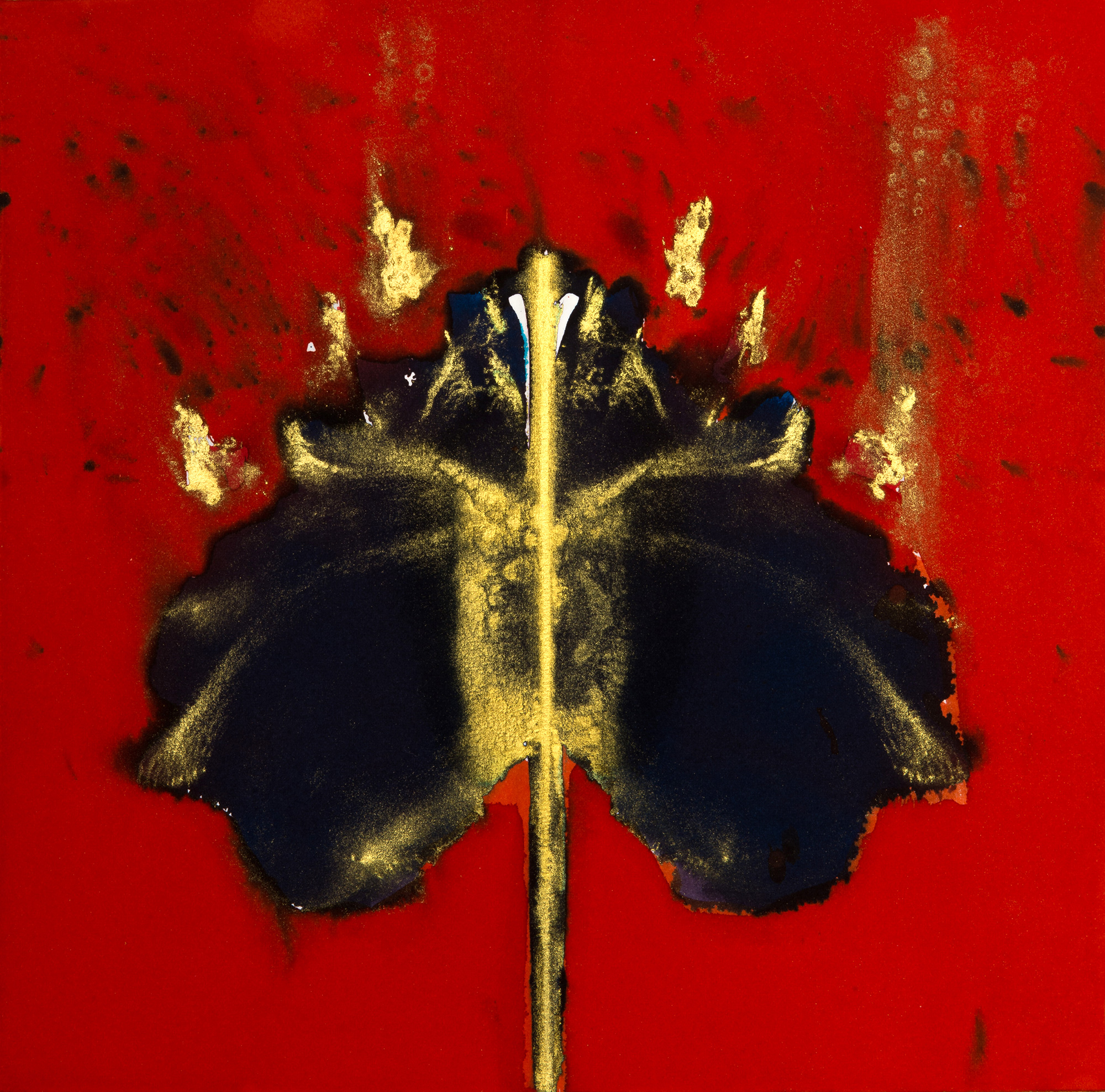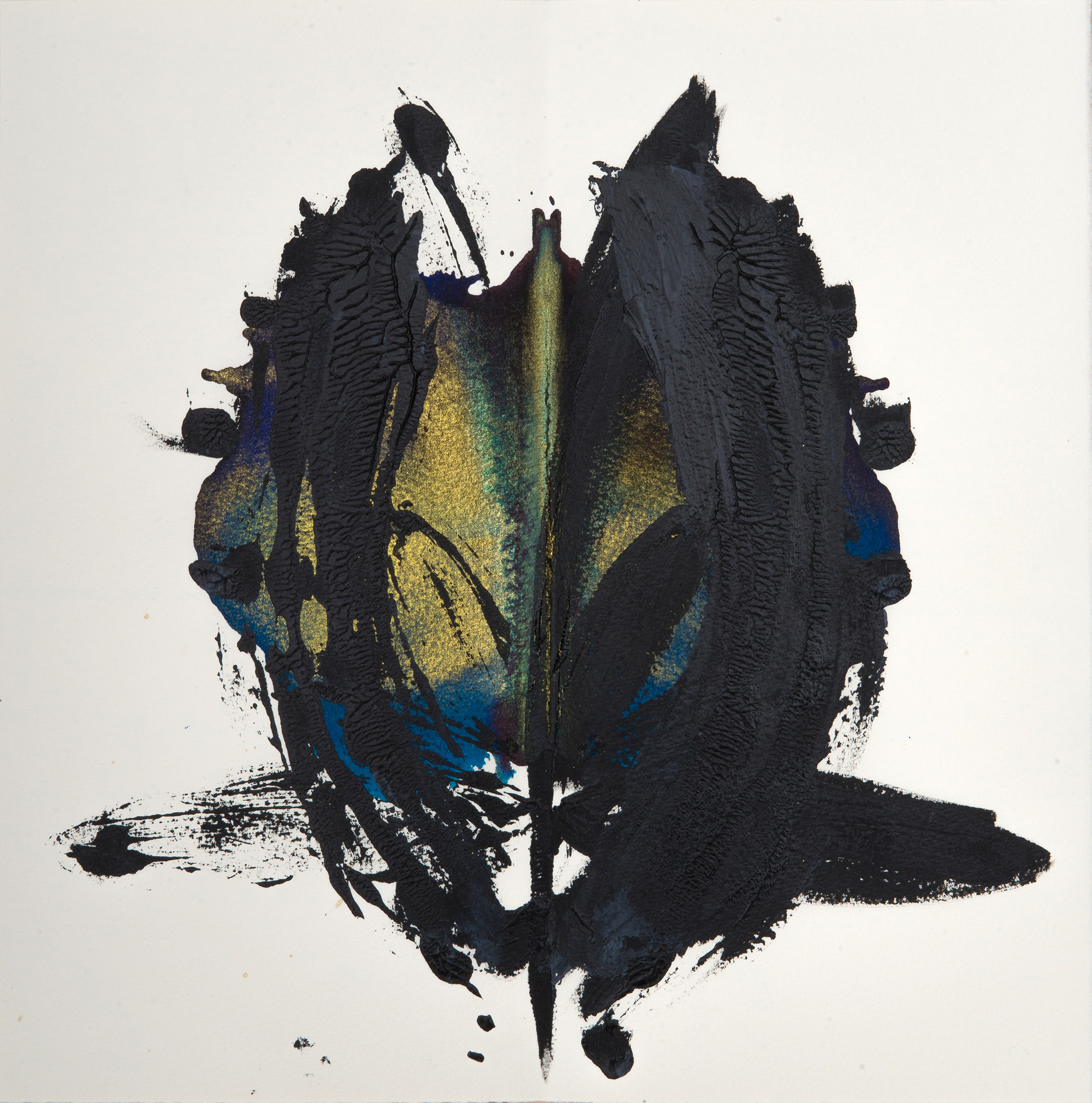KHEN SHISH
☰
☰
x
- ← DELIBERATELY RANDOM
- Timna Seligman
- 2019
Israeli artist Khen Shish, born in Safed in 1970, has been active on the local and international art scene since the mid-1990s. From the start, her style was immediately recognizable, whether in works on paper, large canvases, or installations. In all these different mediums, she has a distinctive free flowing, almost doodle-like, style. Although this lends her works an air of spontaneity, they are actually assiduously planned, often using a personal lexicon of motifs of birds, hearts, leaves-tears-eyes, flowers, and faces that has been built upon over the years and may be seen in the larger paintings displayed here.
"Deliberately Random" presents a new body of work that began with a group of smaller pieces focusing on a process rather than an image. Black blots (usually acrylic paint rather than the expected ink) cover the center of the page, their edges undefined yet symmetrical – Rorschach-like mirror images that were created by folding the page in two. To these chance shapes, Shish first added small embellishments in gold paint, gold leaf, or myrtle twigs and then amplified the paintings to highlight internal images that she saw in the blots. In this way, the works examine what lies between the random and the intended.
A second series, reminiscent of the sensual lushness of Georgia O’Keeffe’s close-up, brightly colored flower paintings, has grown out of the Rorschach experiments. These works blend the black and gold with shades of red, blue, yellow, orange, purple, and green. The flowers are intimate, but also decorative in a way that the more enigmatic black images are not. This could be because of their obvious sexual symbolism, grounded in centuries of cultural imagery (from the Song of Songs) to Robert Mapplethorpe) or their rich use of color. Seen side by side, it is clear that both series are anchored in the same process: controlled experimentation surrendering to the unexpected, subconscious stimulation of the image. As with so much of Khen Shish’s art, the works seen here – whether luxuriant or more austere – seduce at first glance, but a more protracted gaze reveals something deeper and, at times, darker.
RORSCHACH
At the beginning of the 20th century, the Swiss psychologist Hermann Rorschach developed a series of ten ink blot mirror images to be used as a diagnostic tool. Khen Shish’s series Looking for a Beautiful Heart, as well as her follow-on works, manifest a clear commonality with classic Rorschach test boards. In both cases, the image is random – its outcome remains unknown until the folded page to which ink or paint has been applied is spread open and the mirrored form is revealed. For Shish, this is the first step. She then examines the blot, searching for an inherent identifiable image within its haphazardness. Rorschach formulated his test for diagnostic evaluation, but the hidden images that Shish finds offer a point of departure for an artistic journey. Although there may be a subconscious aspect to what she discerns, psychological insight is not the goal. Once she finds inspiration within the pigment, she adds to it, emphasizing the image and elucidating it with touches of gold paint, colored inks, or additional black. She no longer relies on the form that occurred on its own; she has progressed beyond the happy accident at the beginning of the process.
Chance is paramount, but as the series evolves, the artist’s control increases and the randomness of the image is reduced. In this she follows in the footsteps of such Surrealist artists as Marcel Duchamp and André Masson, who played with chance as part of the creative process.
MYRTLE
A repeated motif in this exhibition is the myrtle leaf and branch, which first appeared in the series Looking for a Beautiful Heart. The green leaf introduces a breath of life into a static context, but as such it must be fleeting: the vibrant green fades to brown; the leaf dries up and becomes brittle. For Shish, however, the myrtle is so much more than a demonstration of ephemerality, an ongoing memento mori. The plant is rooted in memories of her childhood in Safed, a forest-ringed city of Jewish mysticism and crisp mountain air. Her father would decorate the annual sukkah – the booth built during the holiday of Sukkot (Feast of Tabernacles) – with bunches of myrtle. Myrtle is one of the four species, plants that play a central role in the Sukkot ritual. Because it has a pleasant fragrance but no taste, myrtle was interpreted as symbolizing those who perform good deeds, but do not study Torah. In today’s world, might that be the ethical humanist or the social activist?
Myrtle has followed Shish down from the mountains to the coastal city of Tel Aviv where she now lives. It grows as hedges on residential streets, and she regularly plucks some as she walks between her home and her studio. It is not only the organic leaves that appear in these works: they have also been painted, photographed, digitally scanned, and printed. Duplicated over and over again, myrtle sprigs have been cut out and applied to the page and to the gallery walls, adding a third dimension to the works.
When Shish first began drawing the leaf-like shapes of eyes, or cutting her eyes out of portrait photographs and adding them elsewhere in her works, she was not inspired by the myrtle leaf. And yet, looking back across her oeuvre, one sees how its shape may be found in her repertory of symbols, from the drooping cyclamen flower, the teardrop, the eye, back to the botanical leaf.

Looking for a Beautiful Heart, 2019, ink and goldleaf on paper approx.30x30

Looking for a Beautiful Heart, 2019, ink and goldleaf on paper approx.30x30